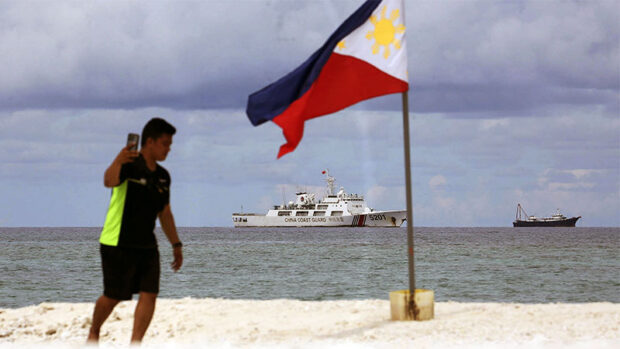PH woos Asean to craft code on South China Sea

PHILIPPINE TERRITORY | In this June 2022 photo, a Philippine Navy member displays a Philippine flag during a visit to Sandy Cay, a sandbar just 7.4 kilometers (4 nautical miles) from Pag-asa Island in the West Philippine Sea. A number of Chinese naval ships were in the vicinity during the Navy’s visit.(Photo by MARIANNE BERMUDEZ / Philippine Daily Inquirer)
HONOLULU — The Philippines is working on a separate code of conduct with neighboring countries such as Malaysia and Vietnam regarding their territorial conflicts in the South China Sea as a broader agreement with China has not been progressing, President Ferdinand Marcos Jr. said on Monday.
The president said talks on a regional code of conduct with China, which claims nearly the entire South China Sea, have been slow and Beijing’s “aggressive” behavior in the disputed waterway has made its relations with the Philippines more tense.
Speaking at a forum at the Asia-Pacific Center for Security Studies here, the President admitted that tensions in the South China Sea were growing “with persistent unlawful threats and challenges against Philippine sovereign rights and jurisdiction over our exclusive economic zone.”
“We are still waiting for the code of conduct between China and Asean and the progress has been rather slow unfortunately,” he said, referring to efforts by the 10-member Association of Southeast Asian Nations.
“We have taken the initiative to approach those other countries around Asean with whom we have existing territorial conflicts, Vietnam being one of them, Malaysia being another and to make our own code of conduct. Hopefully, this will grow further and extend to other Asean countries,” the president noted.
He added that the increasing tensions in the South China Sea required that “we partner with our allies and our friends around the world, so as to come to some kind of resolution and to maintain the peace.”
In November 2002, members of Asean and China signed in Phnom Penh a nonbinding declaration on conduct in the South China Sea, the first time that China accepted a multilateral agreement over the disputes in the region.
Though the declaration fell short of a binding code of conduct, as the Philippines had sought, the agreement was pushed to ease tensions in the area and create guidelines for conflict resolution.
Members of Asean have been trying to obtain China’s endorsement of international norms of behavior over the issue since 1992 when Asean issued its first statement on the disputes.
The regional grouping first became involved in the South China Sea problem in July 1992 and issued a declaration that urged unnamed parties “to exercise restraint” and for the first time called on “all parties concerned to apply the principles contained in the Treaty of Amity and Cooperation in Southeast Asia as the basis for establishing a code of international conduct over the South China Sea.”
Asean officially endorsed the idea of a code of conduct in 1996.
After two years of inconclusive negotiations, China and Asean settled for a nonbinding Declaration on the Conduct of Parties in the South China Sea (DOC) in 2002.
In 2005, the first draft of guidelines to implement the DOC was drawn up, but it was not adopted until 2011.
China has since refused to discuss it further, arguing that the time was not ripe yet and preferred to deal with individual claimants through bilateral negotiations.
Series of violations
“The law is clear as defined by the Unclos and the final and binding 2016 award on the South China Sea arbitration,” Marcos pointed out, referring to the United Nations Convention on the Law of the Sea and the July 12, 2016, ruling of the Permanent Court of Arbitration in The Hague, Netherlands, invalidating Beijing’s nine-dash line claim that covered nearly the entire South China Sea.
“Supported by the rules-based international order and our growing partnerships, both time-tested and new ones, we will insist on the preservation of the sovereignty and integrity of the country, while working closely with international partners in the bilateral, regional, and multilateral settings in developing rules and processes to address these challenges,” Marcos said.
He thanked the United States and the growing number of allied countries in support of the Philippines’ position in the South China Sea, but he said “rhetoric is not enough.”
“We need to upgrade our defense and civilian law enforcement capabilities not only to defend ourselves but also to enable us to become a reliable partner in promoting and guaranteeing regional security,” he said.
Without mentioning Beijing, he said Manila’s regular routine and resupply missions to Ayungin (Second Thomas) Shoal have been subjected to “coercive tactics and dangerous maneuvers of coast guard and maritime militia vessels in the West Philippine Sea, putting the lives of our people at risk, and challenging the rule of law.”
According to him, there are also rampant illegal, unreported, and unregulated fishing and militarization of reclaimed features in the South China Sea.
He likewise cited the presence of maritime militia vessels and reef damage in Escoda (Sabina) and Rozul (Iroquois) Reefs.
The President disclosed that China had shown interest in shoals and sea features that were “closer and closer” to Philippine coastlines, with the nearest shoal about 111 kilometers (60 nautical miles).
“Unfortunately, I cannot report that the situation is improving. The situation has become more dire than it was before,” he said, adding that some features in the South China Sea were “slowly turned into military bases.”
—WITH REPORTS FROM INQUIRER RESEARCH AND REUTERS
For comprehensive coverage, in-depth analysis, visit our special page for West Philippine Sea updates. Stay informed with articles, videos, and expert opinions.